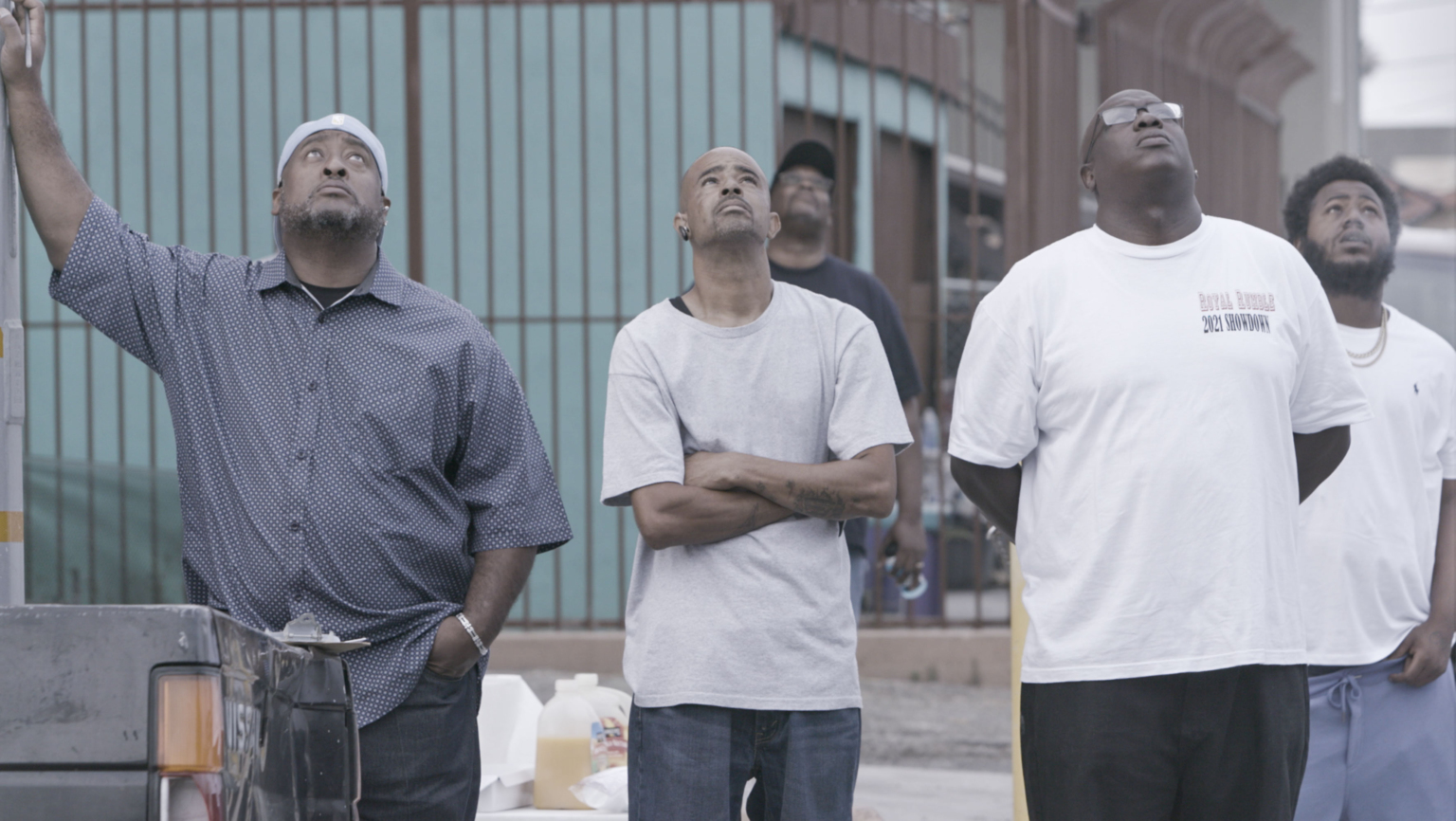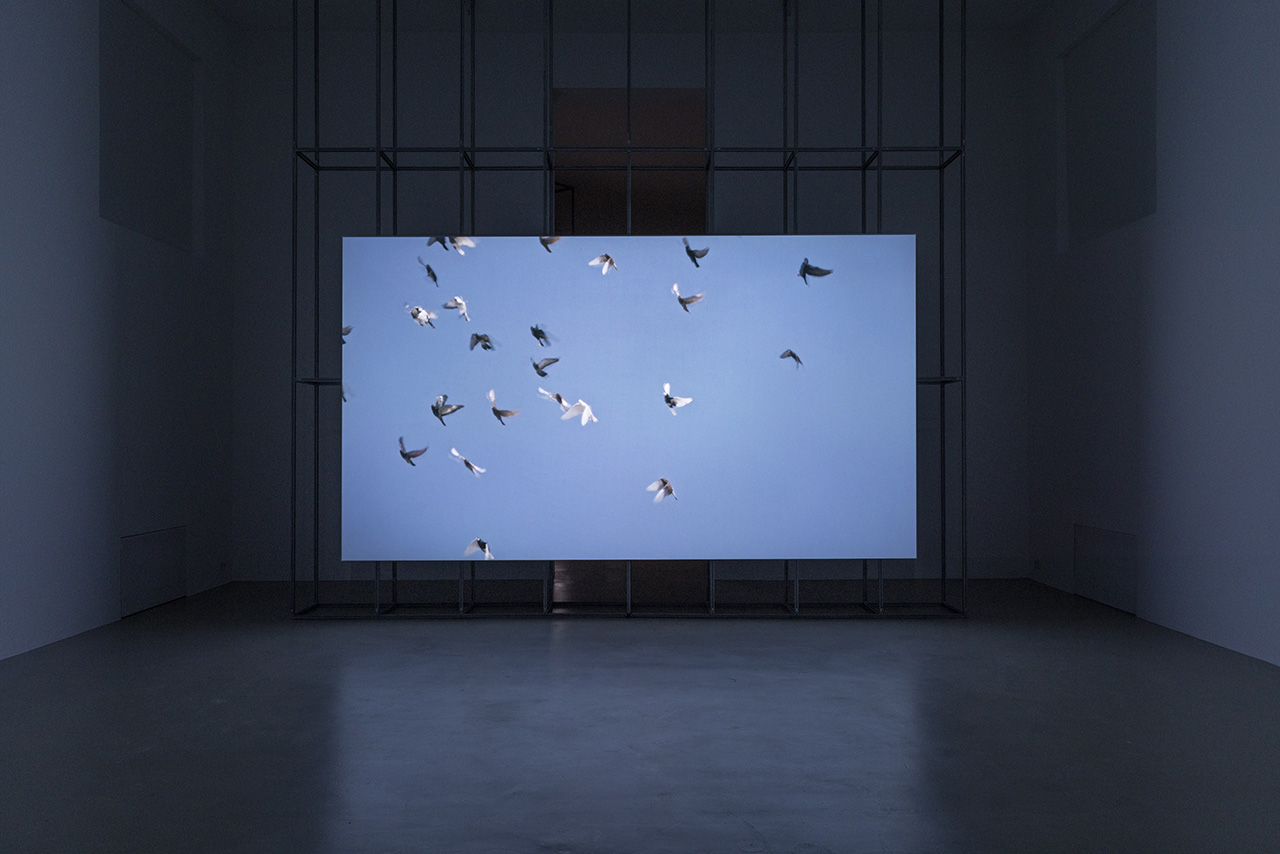It’s a warm summer day and a group of men gaze patiently and attentively up at the bright blue sky. Some of the observers use their hands or baseball caps to shield themselves somewhat from the strong sunlight. The camera takes its time to slowly scan their faces without initially revealing what exactly has captured their attention. Finally, the light blue of the sky fills the entire frame and focuses in slow motion first on a single pigeon and then on an entire flock. Like the gaze of the men who are revealed to be a group of birdwatchers the camera now remains trained solely on the birds, and they in turn seem to follow inaudible commands, flying sometimes in the one direction and then in the other while a few pigeons perform veritable somersaults in the air.

Yalda Afsah, SSRC, 2022, film still, Image via yaldaafsah.com
In her new video work “SSRC” (2022), German-Iranian artist Yalda Afsah gives us an insight into the titular Secret Society Roller Club in Compton – that notorious suburb of Los Angeles whose daily life is dominated by gang crime and a high murder rate. At SSRC, everything revolves around so-called roller pigeons, special types of pigeons capable of performing various tricks such as somersaults or pirouettes in flight. The birds are highly popular amongst pigeon fanciers who use them for flying competitions. In “SSRC”, Afsah presents the pigeons’ spectacular feats in the air in cineaste slow-motion shots as they suddenly take a dive in mid-flight and while doing so perform multiple somersaults. This is alternated with snippets of dialog between the club members also caught by the camera, short stories from the pigeon fanciers or shots of the birds in their home pigeon lofts.

Yalda Afsah, SSRC, 2022, Installation view Every word was once an animal, Kunstverein München 2022, Image via yaldaafsah.com
“SSRC” is the latest work in a series in which the artist explores the ambivalent relationship between humans and (domesticated) animals; and on each occasion the work homes in on a very specific interaction between them: pieces such as “Tourneur (2018), “Vidourle” (2019) and “Centaur” (2020), for example, address the topics of care and subjugation within horse training or the tradition of bullfighting. In doing so the artist avails herself of a documentary form that is however repeatedly interrupted in the course of the works. And thus Yalda Afsah also subtly alienates the sound level in “SSRC” – oscillating between naturalistic, hyper-realistic original sounds and her own sound design – and captivates observers with her poetic visual presentation that clearly stands out from a naturalistic documentary style.
Men Cling to the Birds Like They are The Last Straw
Likewise in “SSRC” the human-animal relationship increasingly comes into focus because in the daily life of Compton the pigeons fulfill a completely different role in addition to the sporting and hedonistic delight in breeding: for the men, who are for the most part Afro-Americans and Latinos, the birds provide a structure and routine for their everyday lives – or as one club member put it: “They keep me out of trouble”. The reason: being a pigeon fancier requires several hours of providing the birds with care, something the club members have to provide day in, day out, and consequently leaves little time for anything else. Yalda Afsah also captures the multifaceted relationship again and again in the close ups of touching: The pigeon fanciers use a dominant, firm grip to hold their pigeons – a grip that seems like a gesture of submission. However, in the course of the film the affection and care in the handling is increasingly revealed, and for their part the pigeons seem to surrender entirely to these emotions. And so you almost have the impression that it is the men who cling to their birds as if to the last straw left to them in everyday life.


Social Cohesion Through Animals
Another film Yalda Afsah has chosen is “Les Proies” (2018) by French director Marine de Contes. The documentary film takes us to a little area of forest in south-west France where a small group of people perform activities that must seem inordinately strange to the unsuspecting audience: In the small hours of the morning one man ties a pigeon to an iron bar, which is then hauled up high into the treetops by a pulley; another man lifts an entire nesting box up to the same height. After the men have set up an oversized net trap they retreat to a kind of shelter.

Movie poster, Marine de Contes, Les Proies, 2018, Image via unifrance.org
Without providing the audience with any explanations Marine de Contes accompanies the clandestine group in the small forest for a good 50 minutes. As the day progresses, they are joined by more and more people, drink tea, watch the sky and birds from a lookout, and at the same time operate strange devices or walk through a long trench system connected to the shelter. Only towards the end of the film do we see confirmed what is hinted at in the title. The reason for the group’s strange activities is revealed: The men are hunters who wait around their unusual hut or hide, a palombière for their prey, the wood pigeons. It was purely by chance that de Contes became aware of this local form of hunting that is hardly known even in many parts of France. Fascinated by the strange structures and self-made devices that the hunters devise the filmmaker decided to document what the men did also cast the unsuspecting viewers into events with no preparation.
So despite its calm presentation “Les Proies” provides a fascinating insight into the everyday life of a highly traditional group of people and traces their involvement with the surrounding flora and fauna. The efforts made by the men far outweigh the results given that the hunters spend up to two months in their elaborately designed palombière, while the prey they catch every day is by no means plentiful. Rather the focus shifts to the special relationship between the members of the group themselves and also their relationship towards fauna and nature. And while the pigeons help create social cohesion in both “SSRS” and equally in “Les Proies” – in the latter case the consequences for the creatures involved are sadly much more drastic.
